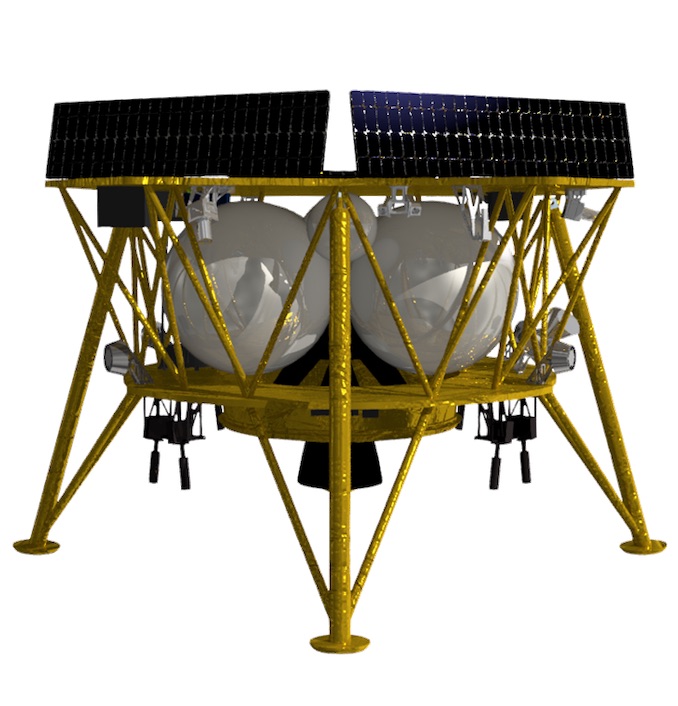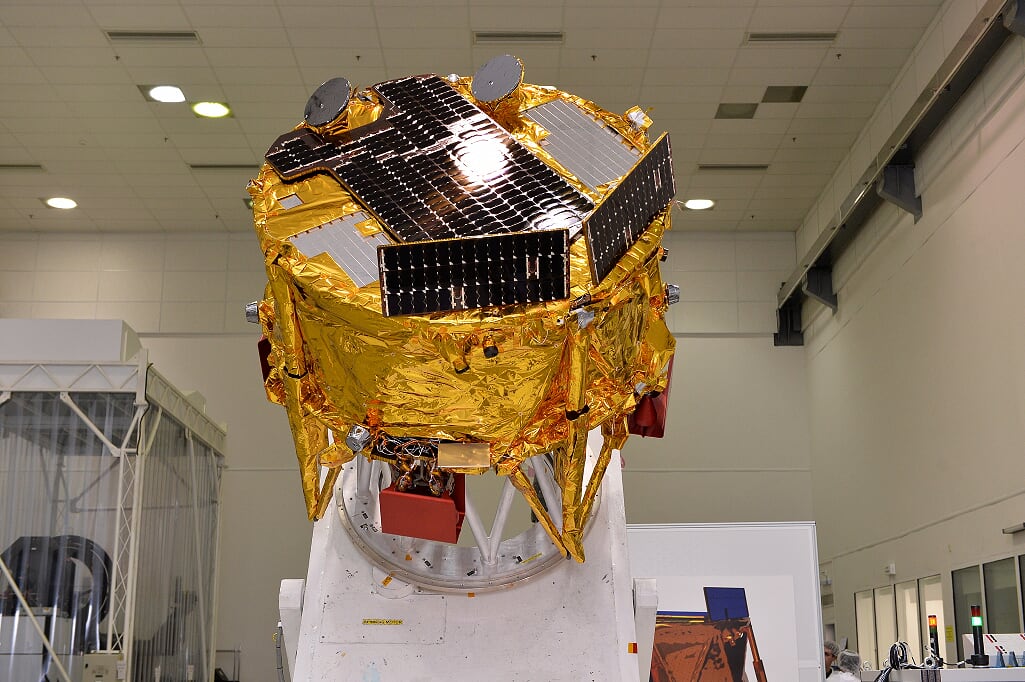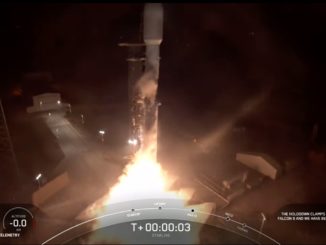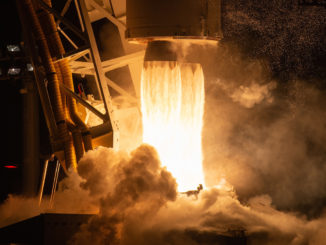
Firefly Aerospace, a Texas-based company which is already developing a small satellite launcher, has signed an agreement with Israel Aerospace Industries to build lunar landers in the United States and carry NASA science instruments to the moon, officials announced Tuesday.
The agreement will permit Firefly to compete with other U.S. companies developing commercial lunar landers to deliver science instruments and other payloads to the lunar surface. Firefly is one of nine companies NASA selected last year to compete for contracts to carry research payloads to the moon through the Commercial Lunar Payload Services, or CLPS, program.
Firefly officials said the commercial lander will be based on the design of the Beresheet spacecraft built by IAI, which attempted to become the first privately-funded mission to achieve a soft landing on the moon in April.
Beresheet crashed during final descent April 11, but it became the first privately-funded spacecraft to orbit the moon on the way to failed landing attempt. The $100 million Beresheet mission was led by SpaceIL, an Israeli non-profit organization that raised funding from wealthy donors, along with financial and labor contributions from IAI, which built the spacecraft.
Firefly’s name for the U.S.-made lander, Genesis, honors the Israeli name Beresheet, which means “genesis” or “in the beginning” in Hebrew.
“Firefly is excited to partner with IAI in architecting a complete lunar science mission for NASA’s CLPS initiative,” said Tom Markusic, Firefly’s CEO, in a press release. “IAI’s culture of engineering innovation and bold vision make our partnership a perfect solution for America as the nation realizes its return to the moon.”
Headquartered in Cedar Park, Texas, Firefly is developing a liquid-fueled smallsat launcher named Alpha capable of delivering up to 2,200 pounds (1,000 kilograms) into a low-altitude orbit.
An artist’s illustration released by Firefly on Tuesday shows a Genesis lander mounted on top of the company’s Beta rocket, the heavier of two launch vehicle configurations Firefly is developing, with three Alpha boosters connected together to form a single launcher.

Earlier this year, Markusic said Firefly was assessing whether to design its own lunar lander, or partner with another company.
“This agreement with IAI will allow Firefly to build on our momentum and expand our lunar capabilities by creating a U.S.-built version of IAI’s historic lunar lander,” Markusic said in a statement. “Having access to flight proven lunar lander technology and the expertise of IAI engineers makes Firefly well placed to gain a foothold in the cislunar market.”
NASA selected the first three companies to win contracts through the CLPS program in May.
Astrobotic, Intuitive Machines and OrbitBeyond won contracts to fly NASA science instruments to the moon in 2020 and 2021. Firefly did not win a contract, but NASA plans additional competitions among the nine CLPS providers for more missions in the coming months and years.
In the announcement, Firefly touted the Beresheet design as “flight-proven.” The other companies eligible for CLPS contracts are developing landers that have not flown in space.
The Beresheet lunar lander launched as a secondary payload from Cape Canaveral on a SpaceX Falcon 9 rocket in February, riding to space alongside an Indonesian communications satellite and a U.S. Air Force smallsat. The spacecraft weighed 1,290 pounds (585 kilograms) at the time of launch, and used its own propulsion to boost itself out of Earth orbit and into orbit around the moon, then commence the landing sequence April 11.
The Intellectual Property and Engineering Support Agreement announced Tuesday between Firefly and IAI will allow for the construction of Genesis landers in the United States. The companies did not specify a location of the Genesis lander manufacturing facility, and a Firefly spokesperson declined to provide additional details.
NASA requires the majority of CLPS lunar landers to be manufactured in the United States. Two other CLPS providers, OrbitBeyond and Draper, are developing lunar landers based on designs from Indian and Japanese teams that competed for the now-defunct Google Lunar X Prize.
SpaceIL also aimed to win the Google Lunar X Prize before the competition ended in 2018 without a winner. The Israeli team continued with the Beresheet mission.
“Firefly Aerospace is excited to partner with Israel Aerospace Industries to provide the only NASA CLPS program flight-proven lander design,” said Shea Ferring, Firefly’s vice president of mission assurance, in a statement. “NASA and the U.S. will greatly benefit from IAI’s next generation lander design, leveraging extensive Beresheet lander design and flight operations experience. Genesis, a predominately U.S.-built version of the lander, delivers a low-cost integrated solution for reliable lunar surface missions.”

Firefly plans to initially launch its Alpha rocket from Space Launch Complex 2-West at Vandenberg Air Force Base in California, a former Delta 2 launch pad. The company says the Alpha’s inaugural launch could happen in December, but is more likely to occur next year.
In February, Firefly announced an agreement with Space Florida to launch from the Complex 20 launch pad at Cape Canaveral Air Force Station. Firefly also plans to build a rocket manufacturing facility at Exploration Park, just outside the gates of NASA’s Kennedy Space Center, near factories already built by Blue Origin and OneWeb.
Firefly also has a production site in Briggs, Texas, to build Alpha launch vehicles.
“The experience gained in the Beresheet moon mission co-developed with SpaceIL puts IAI at the forefront of lunar lander technology and enables us to undertake additional lunar missions with proven technology and significant engineering experience and know-how,” said Boaz Levi, IAI’s executive vice president and general manager of the systems, missiles and space group. “We are proud to partner with Firefly Aerospace and offer NASA our experience in rapid and affordable lunar missions, including all lessons learned from the Beresheet endeavor.”
After the crash of Beresheet, SpaceIL initially said it would try again to achieve a lunar landing. But the non-profit said last month that those plans are changing.
“This time, we will not go to the moon,” SpaceIL tweeted June 25. “Beresheet’s journey to the moon was already received as a successful, record-breaking journey. Instead we will seek out another, significant objective for Beresheet 2.0. More details to follow…”
IAI officials said before Beresheet’s launch that they originally did not see much of a future for SpaceIL’s custom-designed lander design, beyond a single mission. But a market opened up for IAI after NASA and the European Space Agency looked at purchasing commercial rides to the moon for science experiments.
NASA hopes the CLPS program will foster a growing commercial market for lunar missions, advance scientific research, and help prove technologies and public-private partnership schemes for a human landing on the moon.
IAI and OHB, a German aerospace company, signed an agreement in January that could build on the Beresheet mission by constructing future commercial landers to ferry scientific instruments and other payloads to the moon’s surface for ESA.
And now IAI could have a role in supporting NASA’s lunar exploration goals.
Email the author.
Follow Stephen Clark on Twitter: @StephenClark1.



